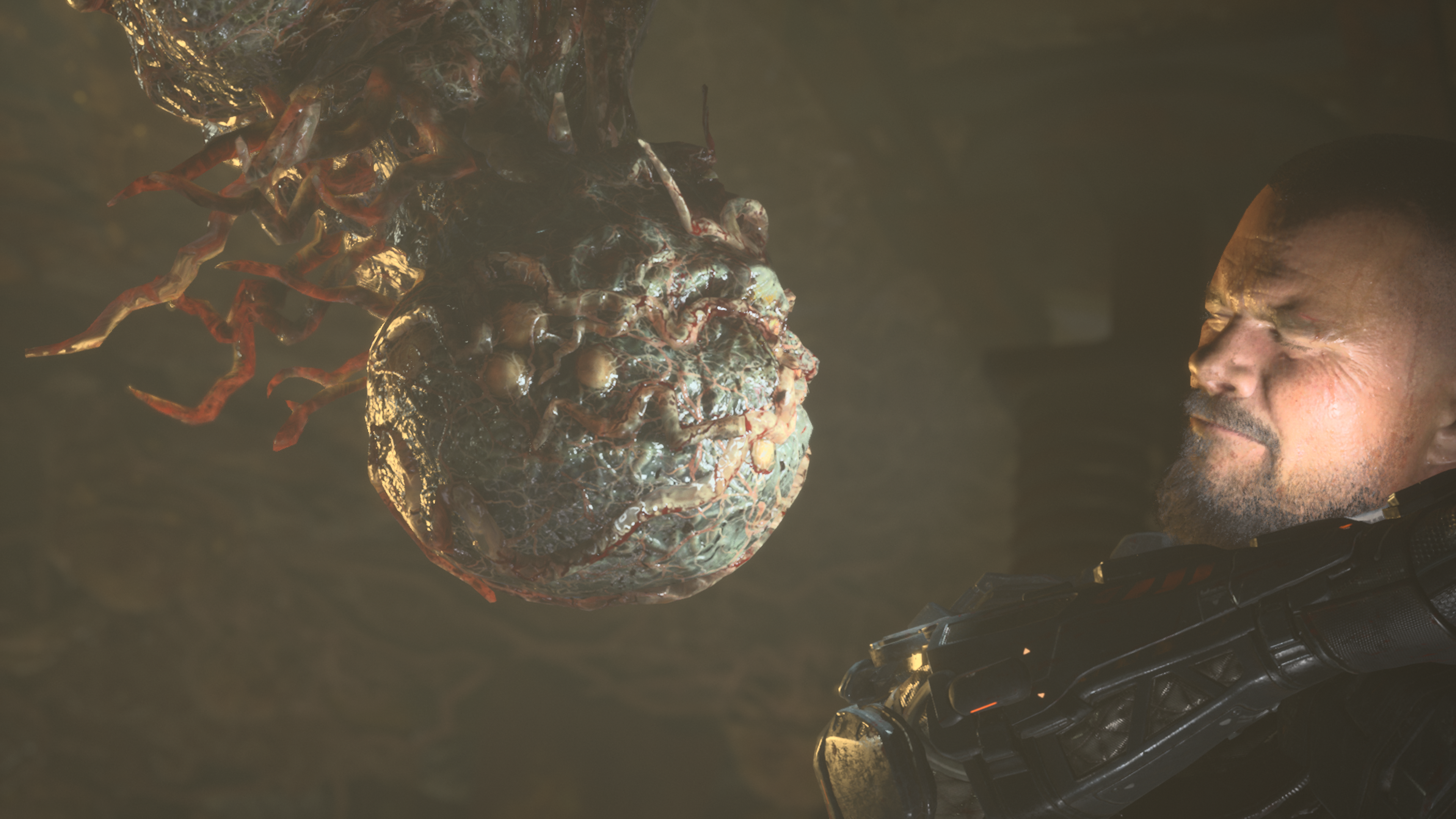Our Verdict
Gory and moody, The Callisto Protocol doesn't mess with the survival horror formula, instead embracing all its beats and clichés to tell a grim sci-fi tale that drips with menace.
PC Gamer's got your back
What is it? Third-person survival horror made by Dead Space veterans.
Expect to pay: $59.99 / £49.99
Release date: December 2, 2022
Developer: Striking Distance
Publisher: Krafton
Multiplayer? No
Link: Official site
The Callisto Protocol begins like all good prison films do: with a mood of unbearable doom. Workingman pilot Jacob Lee has crash-landed on the dead moon of Callisto, after his cargo ship is boarded by a notorious terrorist group. Someone else has died a bizarrely gruesome death during the crash, and we are given ample opportunity to study this misfortune. Next, Lee is arrested, and it's made clear that he has a life spent in the moon's Black Iron prison to look forward to. But almost immediately the prison falls afoul of some mysterious disaster that turns its inhabitants into crazed mutants.
These events cascade efficiently during the first half-hour, and what better way to set the tone of a relentlessly gory survival horror game than with a disaster, an injustice, and then the abrupt invasion of some walking pus buckets? The Callisto Protocol is not subtle about dropping us into a place of utmost dread. Somewhat counterintuitively, dread is strangely comfortable for us, the players of this determinedly nasty horror game. The stakes are clear: Lee, played with action hero stoicity by Josh Duhamel, is in deep shit and must dig himself out of it. Perhaps we'll learn a bit about that terrorist group. Inevitably, some subplots will creep in, and we'll meet some characters who keep us company. But The Callisto Protocol wastes no time cementing the terror of its setting. Now we just need to walk in a mostly straight line for 15 hours and butcher our way through it.

I'm not joking when I say that The Callisto Protocol is a comforting videogame, albeit on the far end of the same axis occupied by, say, Dragon Quest. Familiarity is comfort, and The Callisto Protocol is a consistent big-budget joyride. The indie horror scene has potent psychological discomfort covered (see Visage, Signalis), and is also the natural home of grindhouse schlock (see Murder House, and countless uncanny PS1 era throwbacks). The big-budget horror game, in the Resident Evil sense, and most saliently in the Dead Space sense, is about roaming moody corridors and getting your shit regularly effed up.
Hallway horror
Boy, does The Callisto Protocol have creepy corridors. The opening hours have all the usual varieties covered: claustrophobic engine rooms with burst valves gushing, access halls, maintenance rooms, aged steel, echoing vents, flickering holographic terminals, subterranean crawl spaces full of pustulent slimy growth. The middle hours, and the late hours, have a lot of that stuff too, though some areas do sprawl a touch, and by the game's end there are some surprising deviations from the "grim dark corridor" format. Is this Dead Space 4? Or the Dead Space 3 that many think should have been? Pretty much both.
These environments are the most obvious source of the weird comfort I mentioned, because in its opening hours the feel of playing Callisto Protocol is very much the feel of playing Dead Space. There's the same pristine, diegetic user interface, the same lumbering, over-the-shoulder control of an emphatically beefy man, and the same freedom to foot-stomp corpses into pools of masticated pudding. The director of The Callisto Protocol is Glen Schofield, who directed the first Dead Space, and he has recreated that game's honed balance of "powerful, yet oh-so vulnerable".
Boy, does this moon colony have an alarming amount of wall-mounted spikes.
I don't fault Schofield for returning to the formula. I grew fond of the way Lee has the turning circle of a kid's toy tractor, and that no matter how feeble an enemy appears you will absolutely not succeed in melee stunlocking them, forcing you to use the somewhat unwieldy left and right dodge system. Why doesn't Lee go full-pelt beast mode like his foes? Why does he move with the burly grace of a slow-mo televised fast bowler? Why does he keep putting his baton away, and why does he retrieve it so slowly? Because this is a horror videogame, and for no better reason than that.

The Callisto Protocol takes a rhythmic approach to hand-to-hand combat, but playing with a controller, over the course of 15 hours I never felt like I could effectively nail the timing of that ostensibly simple evasion system. Perhaps I'm just bad at it, but in the heat of the moment—and especially when coping with more than one enemy—I often resorted to panic-shooting. When it comes to the actual bludgeoning though, it's satisfyingly vicious, especially when broken up with point-blank shotgun rounds.
Gravity crush
Lee has a glowing green bar on the back of his head that indicates his health, and a blue one that indicates whether his "GRP" has overheated. The GRP is The Callisto Protocol's answer to Control's levitate, or Half-Life 2's gravity gun, and it's great fun. In a game full of spongey baddies, this weapon lets you pick most of them up and toss them off platforms and into chasms, or more frequently, into wall-mounted spikes. Boy, does this moon colony have an alarming amount of wall-mounted spikes. Or, you can pick up nearby explosives and toss them at your foes, which is less fun, but more sensible because picking up objects uses less energy than levitating mutants.

This addition of a "delete enemy" button to survival horror is disorientating at first, but The Callisto Protocol gradually compensates for it. After receiving the GRP, I forgot I had it for a while. I continued to bash away at baddies with my baton. Finding myself overwhelmed by one particular encounter, I turned to the GRP and, yes: simply picking the bastards up and tossing them to their deaths turned out to be far more expedient. Once I learned to go into every combat situation alert to environmental hazards to turn into weapons, this approach to combat clicked.
I don't find The Callisto Protocol's excessive approach to gore very interesting or shocking—just gross, really—but thankfully it doesn't lean on blood and guts at the expense of setting an utterly grim atmosphere.
GRP energy is finite, but like the ammo reserves for Callisto's five ranged weapons (all standard fare, with hard-hitting upgrade paths), I never found myself desperately wanting for resources on medium difficulty. I actually turned to selling ammunition and occasionally health in order to level up my abilities at the regular 3D printer workstations. I focused on the GRP as soon as I realised how useful it was, though I eventually felt like I should have invested more into the regular weapons too, because the GRP is basically useless during some of the more torturous late-game fights. You won't fill all upgrade paths in a single playthrough though, so it's worth investing early in your preferred method of death-doling.

Ludicrous gibs
I've got used to having to decide between ray tracing or having an extra 40 frames per second, and usually I go with the fps. It's the same in The Callisto Protocol. With a 3080 it ran below 60fps with ray tracing on, and then jumped to about 100 when I turned it off. Setting FSR 2.0 to performance mode gave me a whole extra 3.5fps, and no other settings tweaks made a noticeable difference. There were definitely some stutters, especially when loading new areas or when camera control is taken away or given back on either side of cutscenes and certain pre-canned animations, which The Callisto Protocol is full of. The faces do look real nice, though. I don't think I've ever seen sweat this believable on videogame characters.
Mutants can be carved up limb-by-limb, less as a matter of tactical precision than as a way to keep the carnage fresh, and your GRP can become so powerful that simply throwing them—not even at spikes—will make those limbs go flying. I didn't find any of the warted, veined, saliva-abundant baddies especially scary, if only because I've played a lot of horror games with enemies just like these, but there are a few loathsome predators that were the exception. It's not the appearance of these more fearsome mutants that's threatening, but how they move around the environments. There's also the ever-lingering threat that if you don't shoot the emerging tentacles off a mutant they'll morph into something more formidable.
Checkpoints are generous enough that, outside of a few prickly areas, I rarely found myself repeating encounters until very late in the game, when the difficulty ramps up dramatically. I was occasionally annoyed by checkpoint placements: often I would spend five minutes selling loot and upgrading weapons at the workstations, only to die shortly after, necessitating the transaction again.
I died a lot in the second half, but at least there was the disgusting novelty of a new death scene. These naturally repeat themselves, with some kept for mid- to late-game, but there are a lot of them and most are astonishingly gross. I don't find The Callisto Protocol's excessive approach to gore very interesting or shocking—just gross, really—but thankfully it doesn't lean on blood and guts at the expense of setting an utterly grim atmosphere. It does that well. But again, in a sordidly comforting, familiar way.

This is a rollercoaster videogame. It's riddled with cinematic videogame clichés. Yes, you'll navigate a crumbling structure that will start to collapse as you cross it. Yes, you'll need to power on a generator by finding three breakers that are located in three dangerous locations. Yep, you'll need to survive a certain amount of time locked in a claustrophobic space as baddies attack you. And naturally, there is more to what's going on than the narrative précis provided above suggests. In a lot of ways, The Callisto Protocol feels like a new, albeit well-qualified studio, singing to the crowd: "We can make the kind of games we know you really, really want." And we, the crowd—most of us anyway—will sing back: "Yes, you can, keep on going."
A big part of me wants a blockbuster horror game to go off the rails a bit, in a way a lot of people hoped Hideo Kojima would with Silent Hills. But it's hard to fault The Callisto Protocol for nailing—or GRPing to a row of wall-mounted spikes—exactly what it sets out to achieve: engaging, linear sci-fi survival horror that spins a deepening dystopian yarn around dozens of stressful encounters. In other words, for the abundant masochists among us: comfort food for weirdos, or Wario Dragon Quest.
Gory and moody, The Callisto Protocol doesn't mess with the survival horror formula, instead embracing all its beats and clichés to tell a grim sci-fi tale that drips with menace.

Shaun Prescott is the Australian editor of PC Gamer. With over ten years experience covering the games industry, his work has appeared on GamesRadar+, TechRadar, The Guardian, PLAY Magazine, the Sydney Morning Herald, and more. Specific interests include indie games, obscure Metroidvanias, speedrunning, experimental games and FPSs. He thinks Lulu by Metallica and Lou Reed is an all-time classic that will receive its due critical reappraisal one day.


